The Apple iPad Review (2012)
by Vivek Gowri & Anand Lal Shimpi on March 28, 2012 3:14 PM ESTGPU Performance
All of our discussions around the new iPad and its silicon thus far have been in the theoretical space. Unfortunately the state of Android/iOS benchmarking is abysmal at best today. Convincing game developers to include useful benchmarks and timedemo modes in their games is seemingly impossible without a suitably large check. I have no doubt this will happen eventually, but today we're left with some great games and no way to benchmark them.
Without suitable game benchmarks, we rely on GLBenchmark quite a bit to help us in evaluating mobile GPU performance. Although even the current most stressful GLBenchmark test (Egypt) is a far cry from what modern Android/iOS games look like, it's the best we've got today.
We'll start out with the synthetic tests, which should show us roughly a 2x increase in performance compared to the iPad 2. Remember the PowerVR SGX 543MP4 simply bundles four SGX 543 cores instead of two. Since we're still on a 45nm LP process, GPU clocks haven't increased so we're looking at a pure doubling of virtually all GPU resources.
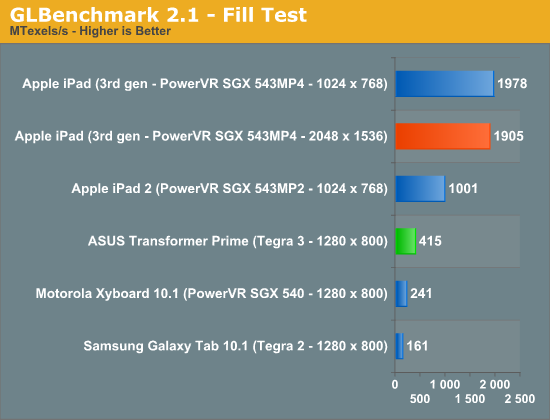
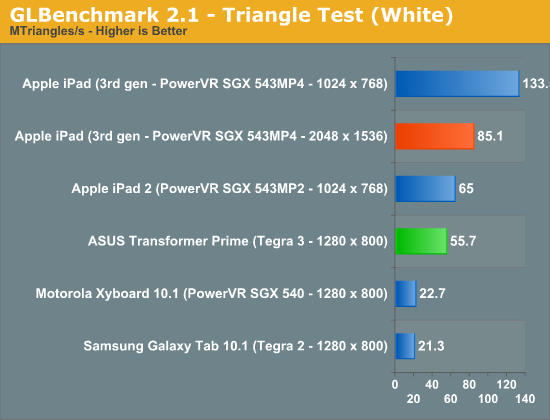
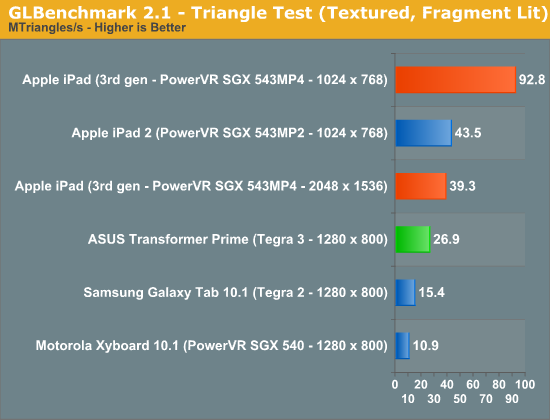
Indeed we see a roughly 2x increase in triangle and fill rates. Below we have the output from GLBenchmark's low level tests. Pay particular attention to how, at 1024 x 768, performance doubles compared to the iPad 2 but at 2048 x 1536 performance can drop to well below what the iPad 2 was able to deliver at 10 x 7. It's because of this drop in performance at the iPad's native resolution that we won't see many (if any at all), visually taxing games run at anywhere near 2048 x 1536.
| GLBenchmark 2.1.3 Low Level Comparison | ||||||
| iPad 2 (10x7) | iPad 3 (10x7) | iPad 3 (20x15) | ASUS TF Prime | |||
| Trigonometric test—vertex weighted |
35 fps
|
60 fps
|
57 fps
|
47 fps
|
||
| Trigonometric test—fragment weighted |
7 fps
|
14 fps
|
4 fps
|
20 fps
|
||
| Trigonometric test—balanced |
5 fps
|
10 fps
|
2 fps
|
9 fps
|
||
| Exponential test—vertex weighted |
59 fps
|
60 fps
|
60 fps
|
41 fps
|
||
| Exponential test—fragment weighted |
25 fps
|
49 fps
|
13 fps
|
18 fps
|
||
| Exponential test—balanced |
19 fps
|
37 fps
|
8 fps
|
7 fps
|
||
| Common test—vertex weighted |
49 fps
|
60 fps
|
60 fps
|
35 fps
|
||
| Common test—fragment weighted |
8 fps
|
16 fps
|
4 fps
|
28 fps
|
||
| Common test—balanced |
6 fps
|
13 fps
|
2 fps
|
12 fps
|
||
| Geometric test—vertex weighted |
57 fps
|
60 fps
|
60 fps
|
27 fps
|
||
| Geometric test—fragment weighted |
12 fps
|
24 fps
|
6 fps
|
20 fps
|
||
| Geometric test—balanced |
9 fps
|
18 fps
|
4 fps
|
9 fps
|
||
| For loop test—vertex weighted |
59 fps
|
60 fps
|
60 fps
|
28 fps
|
||
| For loop test—fragment weighted |
30 fps
|
57 fps
|
16 fps
|
42 fps
|
||
| For loop test—balanced |
22 fps
|
43 fps
|
11 fps
|
15 fps
|
||
| Branching test—vertex weighted |
58 fps
|
60 fps
|
60 fps
|
45 fps
|
||
| Branching test—fragment weighted |
58 fps
|
60 fps
|
30 fps
|
46 fps
|
||
| Branching test—balanced |
22 fps
|
43 fps
|
16 fps
|
16 fps
|
||
| Array test—uniform array access |
59 fps
|
60 fps
|
60 fps
|
60 fps
|
||
| Fill test—Texture Fetch |
1001483136 texels/s
|
1977874688
texels/s |
1904501632
texels/s |
415164192
texels/s |
||
| Triangle test—white |
65039568
triangles/s |
133523176
triangles/s |
85110008
triangles/s |
55729532
triangles/s |
||
| Triangle test—textured |
56129984
triangles/s |
116735856
triangles/s |
71362616
triangles/s |
54023840
triangles/s |
||
| Triangle test—textured, vertex lit |
45314484
triangles/s |
93638456
triangles/s |
46841924
triangles/s |
28916834
triangles/s |
||
| Triangle test—textured, fragment lit |
43527292
triangles/s |
92831152
triangles/s |
39277916
triangles/s |
26935792
triangles/s |
||
GLBenchmark also includes two tests designed to be representative of a workload you could see in an actual 3D game. The older Pro test uses OpenGL ES 1.0 while Egypt is an ES 2.0 test. These tests can either run at the device's native resolution with vsync enabled, or rendered offscreen at 1280 x 720 with vsync disabled. The latter offers us a way to compare GPUs without device screen resolution creating unfair advantages.
Unfortunately there was a bug in the iOS version of GLBenchmark 2.1.2 that resulted in all on-screen benchmarks running at 1024 x 768 rather than the new iPad's native 2048 x 1536 resolution. This is why all of the native GLBenchmark scores from the new iPad are capped at 60 fps. It's not because the new GPU is fast enough to render at speeds above 60 fps at 2048 x 1536, it's because the benchmark is actually showing performance at 1024 x 768. Luckily, GLBenchmark 2.1.3 fixes this problem and delivers results at the new iPad's native screen resolution:

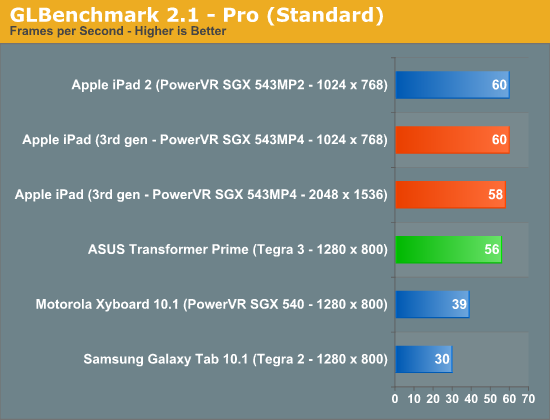
Surprisingly enough, the A5X is actually fast enough to complete these tests at over 50 fps. Perhaps this is more of an indication of how light the Egypt workload has become, as the current crop of Retina Display enhanced 3D titles for the iPad all render offscreen to a non-native resolution due to performance constraints. The bigger takeaway is that with the 543MP4 and a quad-channel LP-DDR2 interface, it is possible to run a 3D game at 2048 x 1536 and deliver playable frame rates. It won't be the prettiest game around, but it's definitely possible.
The offscreen results give us the competitive analysis that we've been looking for. With a ~2x die size advantage, the fact that we're seeing a 2-3x gap in performance here vs. NVIDIA's Tegra 3 isn't surprising:
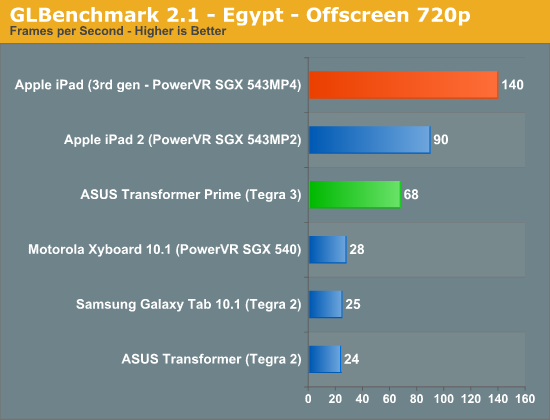
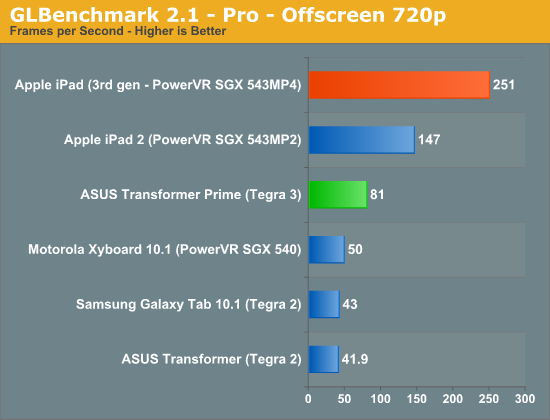
The bigger worry is what happens when the first 1920 x 1200 enabled Tegra 3 tablets start shipping. With (presumably) no additional GPU horsepower or memory bandwidth under the hood, we'll see this gap widen.










234 Comments
View All Comments
Jamezrp - Wednesday, March 28, 2012 - link
Didn't want to cause Verizon too much trouble? Heh, very funny. I am amazed at how the iPad ends up being an amazingly good Wi-Fi hotspot. It almost seems like business users should opt to get an iPad for that function alone. I know plenty of people who would be happy to keep it in their bag, with the hotspot feature enabled constantly, while travelling about. Even for the price there is nothing even close that can compare.Plus, you know, you get the tablet too.
supertwister - Wednesday, March 28, 2012 - link
"It’s a quantum leap from the noisy, 0.7MP mess that was the iPad 2 camera."Interesting choice of word considering a quantum is the smallest possible division for a quantity...
omion - Wednesday, March 28, 2012 - link
Quantum leap:(n) an abrupt change, sudden increase, or dramatic advance
The phrase comes from the ability of particles to make a sudden jump between two energy levels. It is a leap (of any amount) between two quantization levels, not a leap of the smallest possible amount.
drwho9437 - Wednesday, March 28, 2012 - link
A large fraction of the die doesn't seem to have a known use? Wondering what could be taking up all that area if not GPU, CPU and memory interfaces/caches... Most other I/O would have small footprints...tipoo - Wednesday, March 28, 2012 - link
The 4S had a larger than usual die for its voice cancellation features that were needed to make Siri work well, the iPad does't have that but it does have voice dictation so some space is probably for that.PeteH - Wednesday, March 28, 2012 - link
A big chunk of it is probably the ISP they talked about when the 4S debuted.Lucian Armasu - Wednesday, March 28, 2012 - link
So this is how I assumed. The new iPad is in fact slower than the iPad 2, if games actually start using the 2048x1536 resolution for their apps, which everyone seems to be encouraging them to do. But once they do that the graphics will either look poorer, or they will be slower than they were on the old resolution, even on an iPad 2.Add that to the fact that apps are much bigger in size with the retina resolution, and the CPU is the same as last year. The new display might look great, but it's obvious that the new iPad is absolutely a step-back in terms of performance, whether it's GPU or CPU we're talking about. Hardly worth an upgrade, especially for iPad 2 owners.
xype - Thursday, March 29, 2012 - link
Blah blah blah performance blah not worth it.I don’t give a shit about theoretical performance that I might be getting if DNA folding software was available for tablets. I really, really give a shit about being able to read website and ebook text without my eyes straining after an hour.
One would think that 10 years after "No wireless. Less space than a nomad. Lame." and Apple raking in millions and billions of profit, those Geek Metrics™ that people are so fond of here (nothing wrong with that, it’s interesting stuff!), would be recognized as completely and utterly worthless to the average population. But apparently not.
The iPad was never ment to replace PCs and Consoles as a hardcore gaming device, and it was never ment as a render farm server replacement. It would be really nice if people realized that, at some point. In the next 5 years, perhaps.
tipoo - Thursday, March 29, 2012 - link
It seems a bit like the 3GS-4 transition, it used the same GPU despite higher resolution and so performed worse at native, although in this case the CPU is unchanged and the GPU is "only" 2x better for 4x the pixels. Developers got around that on the 4 by making games for the old resolution and using upscaling mode. I'd imagine they will do the same here once games hit the limits of the GPU at native. Games like Infinity Blade 2 also use separate resolutions for things like the menus vs shadows vs terrain textures.darkcrayon - Thursday, March 29, 2012 - link
I guess if the only thing you bought an iPad for were games, and you could only consider a game to be worthwhile if it were drawn directly at 2048x1536, you'd have a point. But of course the new iPad could play games at the "iPad 2" resolution at much higher detail, or at a slightly resolution with the same detail, etc.It doesn't make sense to say it's a step backward in performance overall- it simply has the option to display much higher resolution graphics that the old model didn't have. The iPad 2 displays 2048 x 1536 text at "0 mhz" so to speak. It's not like you are losing anything by having the option of ultra high resolution if the type of game (or app) can use it within the hardware capabilities.